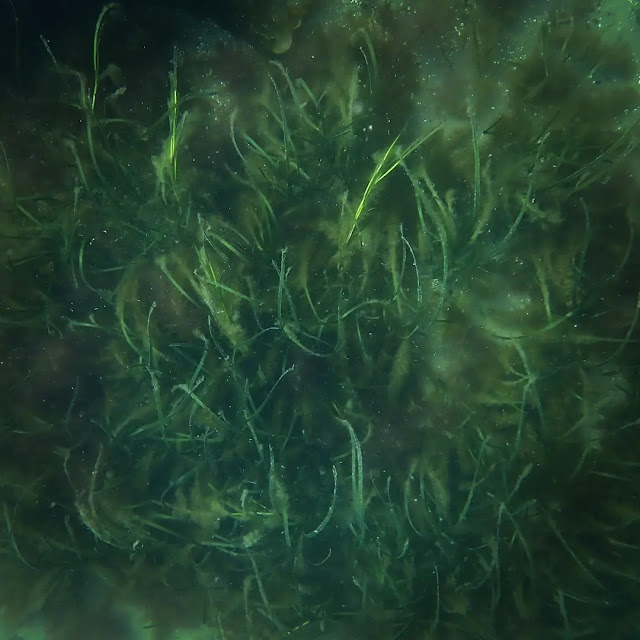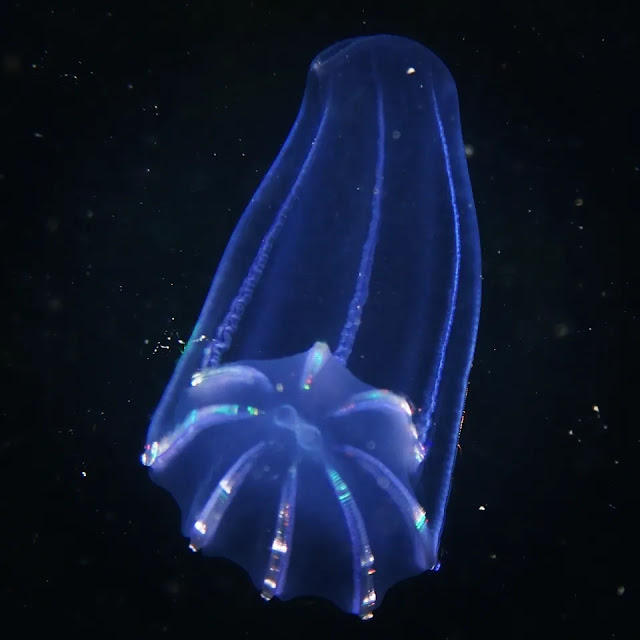For much of the spring and summer, Skomer is a hive of
activity with over a million seabirds filling the cliffs and burrows, many of
them busily raising chicks. The sights, smells and sounds of this breeding rush
are hard to miss, from puffins diving into burrows with beaks full of sandeels
to the cacophony of calls from the cliffside colonies. This abundance of life,
however, is only the tip of the iceberg; equally impressive natural wonders reside
beneath the waves.
 |
| Shanny © Becci Jewell |
 |
| Blue jellyfish © Becci Jewell |
 |
| Moon jellyfish © Becci Jewell |
Dive in and take a moment to recover from the shock of the
chilly Atlantic waters. Once your breath has slowed and your eyes adjusted, a
multicoloured world awaits. Seaweeds in all shades of brown, red and green rise
from the seabed, keeping time with the wash of the waves. Splotches of bright
pink encrusting algae coat the rocks beside cushions of vibrant orange
breadcrumb sponge and clusters of lemon-yellow dogwhelk eggs. A pulsating
rainbow appears before you as a translucent comb jelly propels itself through
the water, beating rows of combs scattering the light in all directions. On
encountering a tasty morsel (friends and family included), this seemingly
featureless creature yawns wide and engulfs their prey in a flash. Smaller and
more spherical but equally as alien, sea gooseberries trail two long tentacles,
fishing on the go. There’s life everywhere you look.
 |
| Comb jelly © Becci Jewell |
The seas around Skomer are so rich in marine life they’ve
been protected by a Marine Conservation Zone since 2014 and were recognised as
a Marine Nature Reserve for 24 years before that. The incredible biodiversity
here is due to the variety of habitats found around the island, the strong
tidal flows, and the influence of warm and cold currents. Steep and exposed
cliffs, wave-swept rocks and sheltered bays provide a multitude of homes for
many different species, the strong tidal flows deliver food and nutrients, and
oceanic currents bring warm-water species from the south and cold-water species
from the north. You’ll find bright red multi-armed sunstars from the north living
alongside scarlet and gold cup corals and yellow trumpet anemones from the
south in a colourful cocktail of marine life.
Two metres tall and with broad brown blades, kelp is a giant
among seaweeds. What’s more, it’s an ecosystem engineer creating habitat and
boosting species richness by providing shelter, habitat and food for a whole
host of marine species. In North Haven, spider crabs shelter amongst the kelp,
clutching at the stipes or lumbering slowly across the seabed on their long,
long legs. Wrasse briefly emerge from the kelp canopy whilst, if you have the
patience to look for them, tiny blue-rayed limpets cling to the blades. These
miniature limpets, with electric blue stripes on their fingernail-sized shells,
graze the algal film found on kelp fronds. What’s more, kelp also absorbs and
stores carbon dioxide, improves water quality and helps buffer the shoreline
from stormy seas – a real champion of our oceans.
 |
| Spider crab © Becci Jewell |
 |
| Blue-rayed limpet © Becci Jewell |
 |
| Kelp forests © Becci Jewell |
There’s more. North Haven is home to seagrass (also known as
eelgrass), the only underwater species of flowering plant found in Britain, and
it’s another ecosystem engineer. Its roots stabilise the sediment in which it
grows, in turn improving water clarity. It provides food and shelter to many species,
and it absorbs and sequesters carbon. Perhaps most importantly though, seagrass
beds are important nursery grounds for a huge number of species including the
juveniles of many commercially important species of fish. Seagrass is very rare
in Wales and is now being actively restored all around the UK, including in
nearby Dale. With such an impressive skillset, it’s little wonder.
 |
| Eelgrass © Becci Jewell |
 |
| Eelgrass © Becci Jewell |
 |
| Sea Gooseberry © Becci Jewell |
 |
| Comb jelly © Becci Jewell |
The range and breadth of marine species that inhabit and depend
on the waters around Skomer is vast. From the tiny Cornish sucker fish
sheltering beneath boulders as the tide retreats, to the much feared (but
incredibly beautiful) jellyfish, the summer schools of mackerel, the seals that
haul out on the beaches, and the squid-scarred Risso’s dolphins that visit the
Sound. All play their part in the dynamic marine ecosystem, the very same
ecosystem on which Skomer’s seabirds depend. Let’s show them some appreciation
on our next visit to Skomer and keep doing all we can to save our seas.
 |
| Cornish sucker fish © Becci Jewell |
 |
| Blue jellyfish © Becci Jewell |
- Becci Jewell, Skomer Volunteer













No comments:
Post a Comment